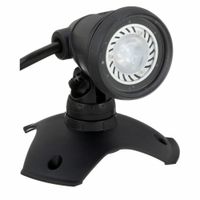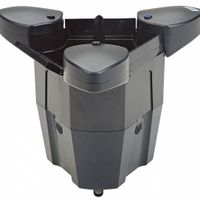Call +(254) 703 030 000 / 751 483 999 / 721 704 777
- Home
- Pumps
- Pond Aeration Fountain Waterfall Pumps
- Pond Fountain Waterfall Treatment Cleaning Lights
.....Read More
Frequently Asked Questions
What are the benefits of using pond and fountain lights?
Pond and fountain lights offer several benefits that enhance both the aesthetic and functional aspects of water features. Firstly, they significantly improve the visual appeal of ponds and fountains, transforming them into stunning focal points, especially at night. The illumination highlights the water's movement and can create mesmerizing reflections and shadows, adding depth and dimension to the landscape.
Secondly, these lights increase safety around water features. By illuminating the area, they help prevent accidents, making it easier for people to navigate around ponds and fountains in low-light conditions. This is particularly important in residential settings where children or pets may be present.
Thirdly, pond and fountain lights can extend the usability of outdoor spaces. By lighting up these features, homeowners can enjoy their gardens and outdoor areas well into the evening, making them ideal for entertaining guests or relaxing after dark.
Additionally, these lights can be used to create specific moods or atmospheres. With options for different colors and intensities, they allow for customization to suit various occasions or personal preferences. This versatility makes them a valuable tool for landscape designers and homeowners alike.
Moreover, modern pond and fountain lights are often energy-efficient, utilizing LED technology that consumes less power and has a longer lifespan compared to traditional lighting options. This not only reduces energy costs but also minimizes environmental impact.
Finally, the installation of pond and fountain lights can increase property value. A well-lit and aesthetically pleasing landscape is attractive to potential buyers, making it a worthwhile investment for homeowners looking to sell in the future. Overall, pond and fountain lights offer a blend of beauty, safety, functionality, and economic benefits.
How do pond and fountain lights sync with fountain spray sequences?
Pond and fountain lights sync with fountain spray sequences through a combination of control systems, software, and hardware components. At the core of this synchronization is a programmable controller, often a PLC (Programmable Logic Controller) or a DMX (Digital Multiplex) controller, which manages both the lighting and the fountain's mechanical operations.
The controller is programmed with sequences that dictate when and how the lights and water jets operate. These sequences are often pre-designed using specialized software that allows designers to choreograph complex shows. The software provides a timeline interface where users can set specific timings for each light and water jet, ensuring they operate in harmony.
The lights used in fountains are typically LED lights, which can change colors and intensity rapidly, allowing for dynamic displays. These lights are connected to the controller via DMX cables or wireless systems, enabling precise control over each light's color and brightness.
The fountain's spray sequences are controlled by pumps and valves, which are also connected to the controller. The controller sends signals to these components to adjust the water pressure and direction, creating various spray patterns.
Synchronization is achieved by programming the controller to send simultaneous or sequential signals to both the lights and the water jets. This coordination ensures that the lights change in color or intensity in perfect timing with the water's movement, creating a cohesive visual experience.
Advanced systems may also incorporate sensors and feedback loops to adjust the performance in real-time, accounting for environmental factors like wind. This ensures the display remains consistent and visually appealing under varying conditions.
What chemicals are best for cleaning ponds and maintaining pH levels?
To clean ponds and maintain pH levels, the following chemicals and substances are commonly used:
1. **Algaecides**: Copper sulfate and chelated copper compounds are effective in controlling algae growth. They should be used carefully to avoid harming aquatic life.
2. **Beneficial Bacteria**: Products containing beneficial bacteria help break down organic matter, reducing sludge and improving water clarity. They also help in maintaining a balanced ecosystem.
3. **pH Buffers**: Sodium bicarbonate (baking soda) is often used to raise pH levels, while muriatic acid or phosphoric acid can lower pH levels. Commercial pH buffer products are also available to stabilize pH levels.
4. **Barley Straw**: When decomposed, barley straw releases compounds that inhibit algae growth. It is a natural and environmentally friendly option.
5. **Pond Dye**: Adding pond dye can reduce sunlight penetration, which helps control algae growth by limiting photosynthesis.
6. **Flocculants**: These chemicals, such as aluminum sulfate, help clear cloudy water by causing suspended particles to clump together and settle at the bottom.
7. **Aquatic Herbicides**: For controlling invasive aquatic plants, herbicides like glyphosate and diquat are used. They should be applied according to guidelines to prevent harm to non-target species.
8. **Lime**: Agricultural lime (calcium carbonate) can be used to increase alkalinity and stabilize pH levels, promoting a healthy pond environment.
9. **Activated Carbon**: Used to remove toxins, odors, and discoloration from the water, improving overall water quality.
10. **Dechlorinators**: If tap water is used to fill the pond, dechlorinators can neutralize harmful chlorine and chloramine.
Regular monitoring of water quality and careful application of these chemicals can help maintain a healthy pond ecosystem.
How do pond vacuums and nets help in maintaining pond cleanliness?
Pond vacuums and nets are essential tools for maintaining pond cleanliness by effectively removing debris and preventing the buildup of harmful substances.
Pond vacuums are designed to suction out sludge, algae, leaves, and other organic matter that accumulate at the bottom of the pond. This accumulation, if left unchecked, can decompose and release harmful gases like ammonia and hydrogen sulfide, which can be detrimental to aquatic life. By regularly using a pond vacuum, you can prevent these substances from breaking down and maintain a healthier environment for fish and plants. Pond vacuums also help in controlling algae growth by removing the nutrients that algae feed on, thus reducing the frequency of algae blooms.
Nets, on the other hand, are primarily used for skimming the surface of the pond to remove floating debris such as leaves, twigs, and dead insects. This prevents the debris from sinking to the bottom and contributing to sludge formation. Nets are also useful for catching and removing larger debris that might not be easily suctioned by a vacuum. Additionally, nets can be used to safely catch and relocate fish during pond cleaning or maintenance activities, minimizing stress and potential harm to the aquatic life.
Together, pond vacuums and nets provide a comprehensive approach to pond maintenance. They help in maintaining water clarity, reducing the risk of disease, and ensuring a balanced ecosystem. Regular use of these tools can significantly extend the life of the pond and enhance its aesthetic appeal, making it a healthier and more enjoyable feature in any landscape.
What is the purpose of pond liners and sealants?
Pond liners and sealants serve crucial roles in the construction and maintenance of ponds, ensuring their functionality, longevity, and ecological balance.
Pond liners are primarily used to create a waterproof barrier between the pond water and the ground. This barrier prevents water from seeping into the soil, which is essential for maintaining the pond's water level and reducing the need for frequent refilling. Liners are typically made from materials like PVC, EPDM rubber, or polyethylene, each offering varying degrees of flexibility, durability, and resistance to environmental factors such as UV radiation and temperature fluctuations. By providing a stable environment, liners help support aquatic life, including fish and plants, by maintaining consistent water conditions.
Sealants, on the other hand, are used to repair leaks or seal joints in ponds, especially in those constructed with concrete or stone. They are essential for patching small holes or cracks that may develop over time due to natural wear and tear or ground movement. Sealants are typically made from silicone, polyurethane, or other waterproof materials that adhere well to various surfaces. They ensure that the pond remains watertight, preventing water loss and potential damage to the surrounding landscape.
Together, pond liners and sealants contribute to the structural integrity and ecological health of ponds. They help in conserving water, reducing maintenance costs, and providing a stable habitat for aquatic organisms. Additionally, they allow for greater design flexibility, enabling the creation of ponds in various shapes and sizes, tailored to aesthetic preferences or specific environmental needs.
How do pond skimmers and waterfall spillways contribute to water feature maintenance?
Pond skimmers and waterfall spillways play crucial roles in maintaining the health and aesthetics of water features.
Pond skimmers are devices that remove debris from the surface of the water. They work by drawing water into a collection basket or net, capturing leaves, twigs, and other floating debris before it can sink and decompose. This process helps maintain water clarity and quality by reducing the organic load that can lead to algae growth and poor water conditions. By preventing debris accumulation, skimmers also reduce the need for frequent manual cleaning and help maintain the ecological balance of the pond, supporting aquatic life.
Waterfall spillways, on the other hand, are structures that facilitate the flow of water over a ledge, creating a waterfall effect. They contribute to water feature maintenance by promoting aeration. As water cascades over the spillway, it traps air and increases oxygen levels in the water. This oxygenation is vital for the health of fish and beneficial bacteria that break down organic waste. Additionally, the movement created by waterfalls helps circulate the water, preventing stagnation and the formation of algae blooms. The aesthetic appeal of waterfalls also enhances the overall visual and auditory experience of the water feature, making it more enjoyable for observers.
Together, pond skimmers and waterfall spillways ensure that water features remain clean, healthy, and visually appealing. They reduce maintenance efforts by automating debris removal and enhancing water quality through aeration and circulation, ultimately contributing to the longevity and sustainability of the water feature ecosystem.
What are the best practices for preventing algae and bacteria buildup in ponds?
To prevent algae and bacteria buildup in ponds, follow these best practices:
1. **Aeration**: Ensure proper aeration to increase oxygen levels, which inhibits anaerobic bacteria and supports beneficial aerobic bacteria. Use fountains, waterfalls, or aerators.
2. **Filtration**: Install a mechanical and biological filtration system to remove debris and support beneficial bacteria that outcompete harmful bacteria and algae.
3. **Regular Cleaning**: Remove debris like leaves and dead plants regularly to prevent decay, which can fuel algae and bacteria growth.
4. **Balanced Fish Stocking**: Avoid overstocking fish, as excess waste increases nutrient levels, promoting algae growth. Follow recommended stocking densities.
5. **Aquatic Plants**: Introduce submerged and floating plants to absorb excess nutrients and provide shade, reducing sunlight penetration and algae growth.
6. **Nutrient Control**: Limit nutrient input by controlling runoff from fertilizers and using phosphate-free products. Consider using barley straw or extract to naturally inhibit algae.
7. **UV Clarifiers**: Install UV clarifiers to kill free-floating algae and bacteria, keeping water clear and reducing the risk of blooms.
8. **Beneficial Bacteria**: Regularly add beneficial bacteria supplements to outcompete harmful bacteria and break down organic matter.
9. **Shade and Cover**: Provide shade using plants or structures to reduce sunlight, which algae need to thrive.
10. **Water Testing**: Regularly test water quality for pH, ammonia, nitrites, and nitrates to maintain a balanced environment.
11. **Algaecides and Bactericides**: Use chemical treatments sparingly and as a last resort, as they can harm beneficial organisms and disrupt the ecosystem balance.
12. **Seasonal Maintenance**: Adjust maintenance practices seasonally, such as increasing aeration in summer and reducing feeding in winter.
Implementing these practices helps maintain a healthy pond ecosystem, minimizing algae and bacteria buildup.




